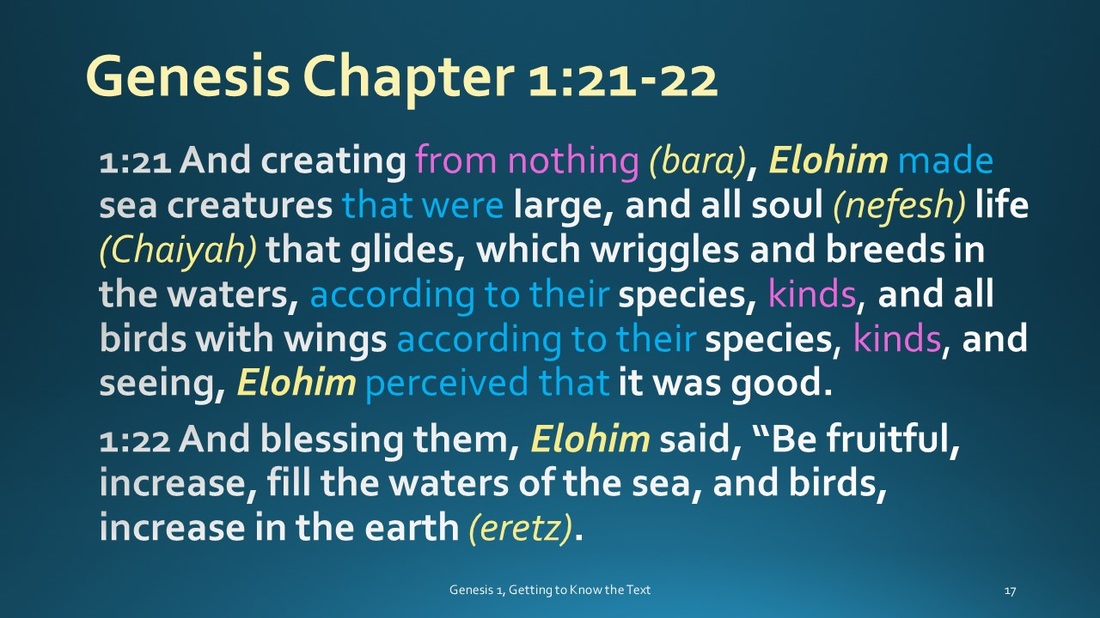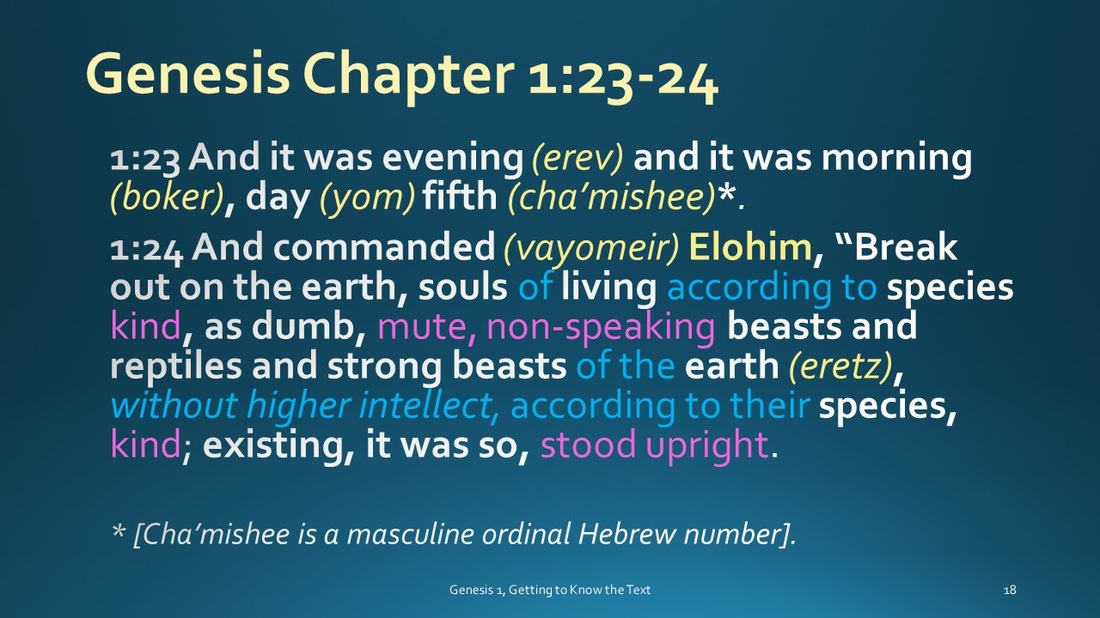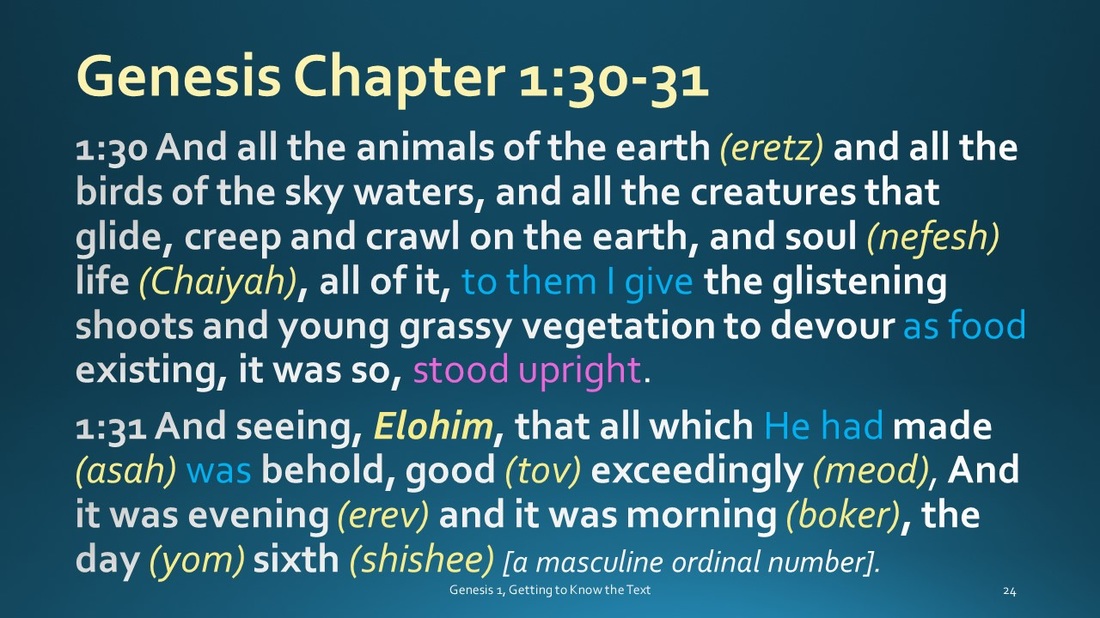Our greatest hope is not found in our enlightened critique of the text but in the Author of it. Introduction:
The primary reasons behind the misinterpretation of the Biblical text are best summed up by Yeshua (Jesus) the Messiah in His response to a question posed by some of the Sadducees, concerning the resurrection of the dead: “Yeshua responded, ‘You are in error, gone astray, seducing and deceiving, knowing neither the Scriptures or the power, the miraculous abundance and strength of G-d.’” –Mattisiyahu /Matthew 22:29 When we rely on our education alone, on empirical data, scientific theory, personal experience or even just plain old—so called—common sense; we often find ourselves at odds with the Author of the text. It’s clear from the context of this quote from the Messiah, that the written Scripture must be “known”, and not merely studied or theorized about. That the miraculous and present power (denoting the work of the Spirit) must be “known”, and not merely experienced in some temporal way. Moreover, our ability to know is reliant on both the Scripture and the Power having first known us. When we bring our intellectual and emotional baggage into our examination of Scripture, we fail to grasp its true meaning. Scripture itself has an agenda, one that we fail to comprehend when looking through the lens of our pretentious objectivity. To demand that the Scripture submit to science, is best described as the fallible seeking to subdue the infallible. “The light shines in the darkness, and the darkness cannot comprehend it” (John 1:5). Am I waging war on science? No! But I resist any mechanism that seeks to manipulate the holy text in order to validate its own agenda. Our greatest hope is not found in our enlightened critique of the text but in the Author of it. No one seeks to learn the true meaning of a book from its readership or from some expert in the genre, to the contrary, the true meaning can only be understood in relationship to the Author. In the end, only the Author is qualified to reveal His work. Therefore, it’s in humility that we come to this text. We ask the Author of creation, the living Word of truth, the Spirit and power of G-d, to unite what is written and the practice of it. We ask that G-d purge our hearts and minds of false premises, human pride and the lies of the satanic agenda; cleansing us instead with the washing of His Word (D’var emet) and the renewing of our minds (Romans 12:2). This is not a new hope, but an ancient one. For every beginning has a goal, and the goal of The Beginning is Salvation (Yeshua). Dating and Penmanship of Genesis: As explained in the previous week’s introduction to Genesis, the Author is G-d Himself and the penman is Moses, aided by Joshua, who annotated, collated and completed the works written by Moses by the inspiration of the Holy Spirit. The dating of the text of Genesis is as varied as the many (fallible) methods of its calculation. I believe the best guess is that it was written in approximately 1400 BCE. Is Genesis a Myth? From ancient times the leaders of Israel, both political and spiritual, have understood the text of the Scriptures to be a trifold collection of documents arranged sequentially as Historical, Prophetic and Poetic books. Within these three categories there are sub-categories which allow for the different types of writing within the base genre. While it is true to say that Rabbinical Judaism latter developed its own pseudo-canonical texts and added a variety of mythological, even esoteric writings, these have never been accepted by the whole as inspired Scripture. The Hebrew Canon remains in structure and form devoid of myth. The Hebrew Canon of Scripture known as the TaNaKH, is arranged as follows: TORAH: Historical, The five books of Moses NEVI’IM: Prophetic, The Books of the Prophets (Also Historical) KETUVIM: Writings, Psalms, Proverbs etc. (Reflections of Historical events and observations of G-d and His creation) Although there are some intersecting points in the various genres. There is one unifying factor, that of the Historical nature of the events that are recorded and expounded upon. It is interesting to note that the Brit Ha-Chadashah (NT) is also arranged in this same order: TORAH: Historical, The four Gospels and the book of Acts NEVI’IM: Prophetic, The Letters to the Community of Faith (Also Historical) KETUVIM: Writings, Revelation Rav Shaul the Shaliach (Paul the Apostle) was aware of the destructive nature of mythos as it began to seep in to the post Hellenistic Jewish culture. He thus thought it necessary to make a clear distinction between the inspired truths of G-d’s Word and the mythology of humanity. As a result he wrote to Timothy and Titus saying: “As I urged you upon my departure for Macedonia, remain on at Ephesus so that you may instruct certain men not to teach strange doctrines, 4 nor to pay attention to myths and endless genealogies, which give rise to mere speculation rather than furthering the administration of God which is by faith.” –1 Timothy 1:3-4 “But have nothing to do with worldly myths fit only for old women. On the other hand, discipline yourself for the purpose of godliness;” –1 Timothy 4:7 “For the time will come when they will not endure sound doctrine; but wanting to have their ears tickled, they will accumulate for themselves teachers in accordance to their own desires, 4 and will turn away their ears from the truth and will turn aside to myths.” –2 Timothy 4:3-4 “For this reason reprove them severely so that they may be sound in the faith,14 not paying attention to Jewish myths and commandments of men who turn away from the truth.” –Titus 1:14 What is abundantly clear from these letters is that Shaul, a devote Pharisee and a Jew of Jews, accepted the teaching of Scripture as factual information and regarded mythos as a contrary impediment to godliness and the understanding of the true nature of the Gospel of Yeshua. Yeshua Himself testifies to the fact that He accepts the writings of Moses as factual information which accurately describes Him: ““Do not think that I will accuse you before the Father; the one who accuses you is Moses, in whom you have set your hope. For if you believed Moses, you would believe Me, for he wrote about Me. But if you do not believe his writings, how will you believe My words?” –Yochanan/John 5:45-47 Based on this succinct statement concerning the integrity and historicity of the Scriptures it is true to say that anyone who calls the Scriptures myth is also calling the Messiah a liar. This is of course blasphemy, which stems from the spirit of anti-Christ. Conclusion: The Scriptures have been transmitted to us as history, prophecy and poetry; all of which convey a factual account of the physical and spiritual history of humanity as the glory of G-d’s creative order. The Hebrew Writing Genre of Genesis: The text of Genesis has an authentic literary continuity that makes it impossible to accept the lie of redactive theory. The genealogies and events read as historical fact rather than legend or parable. The characters of Genesis are affirmed as individuals by the wider body of Scripture and even the Messiah Himself is likened to the individual Adam, the first human being. The consistency of the two accounts of creation recorded in Genesis 1-3, and the subsequent genealogies stemming from the first created human being Adam, show that the intention of the Author was to convey a literal historical account using pictorial language to convey the complexity of both the overview (Genesis 1) and the detail of the creation of humanity as the glory of creation (Genesis 2-3). As stated previously, the book of Genesis is part of the Torah, a grouping of historical books upon which the very existence and history of the ethnic people Israel is established. Genesis was not included in the Neviim (Prophets) or the Ketuvim (Poetry) because it was not considered to be of the same genre or importance as either of these two categories. It is true to say that the Torah (Genesis) is the historical starting point for all that proceeds from it. While it uses pictorial language (something you and I use on a daily basis when conveying factual information), it is neither poetic nor allegorical. This places Genesis in stark contrast to the New Testament book of Revelation, which is in the category of Ketuvim (Poetry, Allegory). Although Revelation draws on the imagery of the factual history of the Genesis account, it is none the less a book that uses an entirely different means of transmission. We are thus able to draw parallels and make correlations but we are not able to use the book of Revelation as evidence for an allegorical, poetic or metaphorical interpretation of Genesis. Conclusion: Genesis, like the other four books of the Torah, uses pictorial language to convey factual, historical information concerning creation and the journey of humanity and subsequently Israel. Thus building the platform for a spirituality reliant on truth rather than mythological subterfuge. Getting to know the text: The purpose of this first study of Genesis 1:1-2:3 is to simply seek to understand the plain meaning of the Hebrew text devoid of the scientific, philosophical, theological, theoretical and emotional baggage that so often drives our desire to comprehend the depths of Scripture. Therefore, I’ve tried to translate the text as literally as possible in the word order of the Hebrew with qualifying illuminations of the Hebrew and supporting English phrases. My hope is that reading the text this way will help the student who has no Hebrew knowledge, to grasp something of the nature of Hebrew thinking. The Text: (Translated from Hebrew by Yaakov ben Yehoshua) Genesis 1:1-2:3 1:1 In the beginning, creating from nothing (bara), Elohim made the waters of the sky, and He made the earth (eretz): 1:2 And the earth came into existence, desolate (tohu) and vacant (bohu), and darkness (choshekh) was over the face of deep, surging, subterranean waters, and the Spirit, Wind, Breath of Elohim brooded (Like a mother eagle), relaxed, over the face of the waters. 1:3 And commanded (vayomeir), Elohim, “Be light (Or)”, and light (Or) was: 1:4 And saw, Elohim, the light (Or), that it was good, and made a distinction, Elohim, between the light (Or) and the darkness (choshekh): 1:5 And proclaimed (Vayikra) Elohim, the light, “day” (yom), and the darkness (choshekh), Elohim proclaimed, “night, spiralling darkness” (laiyla) and there was evening (erev) and there was morning (boker), day (yom) one (echad), a compplex and intense unity. [Echad is a cardinal masculine Hebrew number that is also the Hebrew root meaning, “complex and intense unity”]. 1:6 And commanded (vayomeir) Elohim, “Be, atmosphere, the visible ach of the sky, a hard shiny surface” by severing the waters and becoming distinct between the waters and from the waters. 1:7 And made (v’yaas) Elohim, the atmosphere, the visible ach of the sky, and distinguished it between the waters that were below the atmosphere and the waters that were above, and the atmosphere came into existence (stood upright). 1:8 And proclaimed (vayikra) Elohim, the atmosphere, “Sky waters”, and it was evening (erev) and it was morning (boker), day (yom) second (shinee) [a masculine ordinal number]. 1:9 And commanded (vayomeir) Elohim, “bind together the waters below the sky waters, uniting them in one place, appearing, the dry ground existed, it was so (stood upright). 1:10 And proclaimed (vayikra) Elohim, the dry ground, “Earth” (eretz), and the mikvah (gathering together) of the waters, He proclaimed, “Seas” (yamim), and saw Elohim, it was good. 1:11 And commanded (vayomeir) Elohim, “Sprout forth from the earth (eretz) vegetation, glistening shoots bearing fertile seed and fruit trees with fruit (p’ree), bearing fruit according to their species (kind) on the earth,” existing, it was so (stood upright). 1:12 And breaking out of the land, vegetation, glistening shoots, fertile seed and fruit according to their species (kind), and trees bearing fruit with fertile seed according to their species (kind), and seeing, Elohim perceived that it was good. 1:13 And it was evening (erev) and it was morning (boker), day (yom) third (shlishee) [a masculine ordinal number]. 1:14 And commanded (vayomeir) Elohim, “Exist luminous bodies, in the expanse (space) above the sky waters, distinguishing between the day (yom) and the night (Laila) and become signs for the seasons of holy gatherings (moadim), and for days, and years.” 1:15 And they came into existence to serve in the expanse (space) above the sky waters, to give the light over the earth, existing, it was so (stood upright). 1:16 And making (yaas) Elohim, the two luminous bodies which were large, made the light that was greater to govern the day, and the light that was smaller to govern the night and the stars, rolling, round, pin pricks, blazing, shining. 1:17 And gave them, Elohim, to be the light in the expanse, visible arch of the sky, above the sky waters, to be light over the earth. 1:18 And to govern in the day and in the night, and to distinguish between the light and the darkness, seeing, Elohim, that it was good. 1:19 And it was evening (erev) and it was morning (boker), day (yom) fourth (revee’ee) [a masculine ordinal number]. 1:20 And commanded (vayomeir) Elohim, “Breed in the waters small creatures, with souls that are living, and let birds that fly be over the earth on the face of the expanse in the sky waters. 1:21 And creating from nothing (bara), Elohim made sea creatures that were large, and all soul life that glides, which wriggles and breeds in the waters, according to their species (kinds), and all birds with wings according to their species (kinds), and seeing, Elohim perceived that it was good. 1:22 And blessing them, Elohim said, “Be fruitful, increase, fill the waters of the sea and birds increase in the earth. 1:23 And it was evening (erev) and it was morning (boker), day (yom) fifth (cha’mishee) [a masculine ordinal number]. 1:24 And commanded (vayomeir) Elohim, “Break out on the earth, souls living according to species (kind) as dumb, mute, non-speaking beasts without higher intellect and reptiles and strong beasts of the earth according to their species (kind), existing, it was so (stood upright). 1:25 And made (yaas) Elohim, alive on the earth, according to their species (kind) animals; behemot (strong mammals) according to their species (kind), and all reptiles and things that creep on the land (ha-adamah) according to their species (kind), and seeing, Elohim perceived it was good. 1:26 And commanded (vayomeir) Elohim, “Let us make humanity (adam) in our image (to resemble us), shaped, modelled on us, having authority to rule, (subjugate, tread down) over the fish in the sea and the bird life of the sky waters and over all of the dumb, mute, non-speaking creatures without higher intellect, of the earth (eretz), and all the reptiles and creeping, gliding, creatures on the earth. 1:27 And creating from nothing (bara), Elohim made the human (ha-adam) in His image (to resemble him), in the image of Elohim He created from nothing, him (humanity); male and female, He created from nothing, them. 1:28 And blessing them, Elohim, and said to them Elohim, “Be fruitful, increase, and fill the earth and rule, (subjugate, tread down) over the fish in the sea and the bird life of the sky waters and over all of the non-speaking creatures of the earth (eretz), and all the reptiles and creeping, gliding, creatures on the earth. 1:29 And said Elohim, “Behold I give you every glistening shoot, seed bearing plant and vegetable, which is on the face of all the earth, all the trees that bear fruit and the plants that produce seed are yours, to be food (eating) for you. 1:30 And all the animals of the earth and all the birds of the sky waters, and all the creatures that glide, creep and crawl on the earth, and soul life, all of it, to them I give the glistening shoots and young grassy vegetation to devour as food existing, it was so (stood upright). 1:31 And seeing, Elohim, that all which He had made (asah) was behold good (tov) exceedingly (meod), And it was evening (erev) and it was morning (boker), the day (yom) sixth (shishee) [a masculine ordinal number]. 2:1 And all the sky waters and the earth, everything was completed and vast, majestic. 2:2 And everything Elohim, in the day seventh (feminine ordinal number), was finished, from the work He had been making (asah), He ceased His work in the day seventh, from all the works which He had made (asah). 2:3 And blessing, Elohim, made it, day the seventh, a holy day, because on it He ceased from all the works created from nothing (bara) which Elohim had made (asah). © 2016 Yaakov Brown Comments are closed.
|
Yaakov BrownFounder of the Beth Melekh International Messiah Following Jewish Community, Archives
February 2024
|



























 RSS Feed
RSS Feed